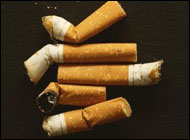Pediatricians not doing enough to stop parental smoking
Parental smoking is a pediatrician’s business, experts say, yet many are reluctant to tell parents to stop smoking and offer little support for efforts to quit, a new study suggests.
The study in the latest issue of the American Journal of Health Behavior found that 80 percent of 153 Ohio pediatricians surveyed said they asked parents about tobacco use and advised them to stop, but involvement generally ended there.
Only 16 percent said they recommend nicotine replacement therapy to parents. Yet according to an earlier survey, “85 percent of parents believed it was acceptable for their child’s physician to recommend such an adjunct for quitting smoking,” the authors wrote.
“Pediatricians felt that ‘the parent is not the patient,’” said lead researcher Joseph Dake, Ph.D, an assistant professor at University of Toledo in Ohio. “Our take is that their smoking status is one of the most important environmental factors in the health of the child.”
An estimated 5,000 children in the United States die yearly from tobacco exposure, and children with household smokers miss an average of six extra school days, according to the study.
Past research has shown that children whose parents smoke are more likely to have wheezing, asthma and bronchitis; sudden infant death syndrome; middle ear disease and other cognitive and behavioral problems. The July Surgeon General’s Report concluded that there is no safe level of secondhand smoke exposure. 
“It’s one thing to know that smoking is bad, but another for a doctor to tell you, ‘I’m going to take some of the precious time we have to talk to you about your smoking, because it’s so important for your child,” said Nancy Rigotti, M.D., director of the Tobacco Research and Treatment Center at Massachusetts General Hospital and Harvard Medical School.
Almost one-fourth of the pediatricians said they saw smoking-cessation counseling to parents as a waste of time or of very limited value, while 39 percent said such counseling had significant value. However, 80 percent said that environmental tobacco smoke in the home of children has a significant effect on their health.
“You can’t really protect a baby by going outdoors,” said Rigotti. “Most pediatricians I know are skeptical when smokers say that they don’t smoke in the house,” she added.
Pediatricians in the study said barriers to counseling included lack of time, reimbursement issues, not perceiving smoking cessation as an area of expertise and not knowing where to send parents for cessation programs or treatment.
“The majority of parents believe it is responsibility of pediatricians to counsel parents about their tobacco use,” said Jonathan Winickoff, M.D., chairman of the American Academy of Pediatrics Tobacco Consortium.
Most parents who smoke would be willing to be enrolled in a free telephone quit line during a routine pediatric visit, Winickoff and fellow researchers found in a study published in the March issue of the journal Pediatrics.
“Parents want the help and would accept medication from the child’s doctor,” he said.
“Even pediatricians who wouldn’t feel comfortable prescribing can talk to parents about over-the-counter nicotine replacement products,” said Rigotti.
Dake said that doctors need to get away from an “all-or-nothing” perspective, and that even if only 20 percent of parents quit smoking, the impact would still be felt.
Winickoff said that a new, free program developed by pediatricians, “Clinical Effort Against Secondhand Smoke Exposure (CEASE),” guides pediatric offices in how to help parents quit smoking and eliminate secondhand smoke exposure of children.
“New mothers and new fathers are a relatively neglected group in health care,” Rigotti said. “You could argue that the best way to give young adults the tools for smoking cessation is to work with pediatricians.”
By Lisa Esposito, Editor
Health Behavior News Service
Revision date: July 5, 2011
Last revised: by Dave R. Roger, M.D.